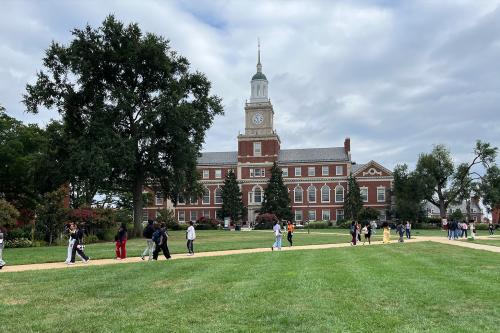
WASHINGTON—Washington, D.C., television viewers can now experience the future of broadcast television as Howard University’s WHUT and four local affiliates of national broadcast networks have launched NEXTGEN TV, a revolutionary new digital broadcast technology based on the same fundamental technology as the internet and digital apps.
Viewers in the Washington metro area can now find five channels over-the-air for free with NEXTGEN TV: WHUT-TV (Howard University, virtual channel 32; PBS); WJLA-TV (Sinclair Broadcast Group, virtual and VHF digital channel 7; ABC); WRC-TV (NBCUniversal, virtual channel 4, UHF digital channel 34; NBC); WTTG (Fox Television Stations, virtual channel 5, UHF digital channel 36; FOX); and WUSA (TEGNA Inc., virtual and VHF digital channel 9; CBS). Howard’s WHUT will convert to the NEXTGEN TV standard and host the other four stations.
The Howard NEXTGEN TV Broadcast Collaborative is a landmark project developed in partnership with the National Association of Broadcasters (NAB) that includes a learning lab where the technology at the forefront of the rollout is developed and demonstrated, underscoring the unique prominence of its public and commercial collaboration.
“Just as technology changes all around us, from our phones to our cars to our homes, NEXTGEN TV is the technological evolution of free broadcast television,” commented Sean D. Plater, general manager, WHUR 96.3 and WHUT-TV, Howard University. “By connecting the IP and broadcast television infrastructures together, we’re able to give viewers a better and more engaging content experience. Viewers across the Washington, D.C., region will be excited to not just watch, but also lean in and be more engaged with their content.”
“The Media Technology Innovation Learning Lab is already living up to its purpose—to foster participation and show how the myriad capabilities of NEXTGEN TV can best be applied for future public service, entertainment, and information objectives,” stated Sam Matheny, executive vice president and chief technology officer, National Association of Broadcasters. “We have tremendous pride in Howard University student Sulaiman Bastien as the first college student in the world to create a NEXTGEN TV app. As the rollout continues, the Lab is poised to replicate more stories of innovation and produce a vibrant ecosystem of broadcasters and app developers.”
“America’s Public Television Stations congratulate WHUT, Howard University, the National Association of Broadcasters and Pearl TV on the official launch of this extraordinary new NEXTGEN TV Broadcast Collaborative,” said Patrick Butler, president and CEO of America’s Public Television Stations. “WHUT and Howard University are enhancing the rich public television tradition of education and innovation, and we couldn’t be prouder of their commitment to educating the next generation of leaders in our industry and to providing an exciting array of new NEXTGEN TV services to the people of the Washington, D.C., region.”
NEXTGEN TV is the evolution of over-the-air (OTA) broadcast television and is the first major overhaul to the Advanced Television Systems Committee’s standard for receiving OTA signals in 25 years. Enabling two-way interactivity and applications with internet connection the new standard offers viewers more localized news and entertainment choices, while providing broadcasters with a more compelling and interactive way to deliver their content.
NEXTGEN TV can deliver:
- Consistent volume across channels
- Added voice clarity with Dolby’s Voice +
- Stunning 4K, High Dynamic Range (HDR) video
- Movie theater-quality sound
- Enhanced internet content on demand
- Advanced emergency alerts and information
- Dual language capabilities
NEXTGEN TV is a feature built into select new TV models manufactured by LG Electronics, Samsung, and Sony—and widely available to consumers with a rapidly growing number of television sets in homes across the U.S. While features available on NEXTGEN TV will vary by sets and by broadcasters as commercial service becomes available in local markets, consumers can feel confident that the television purchased today with a NEXTGEN TV logo will keep in lock step with future technology enhancements. Furthermore, NEXTGEN TV is supported by an ecosystem of low-cost accessory devices that will also enable the conversion to NEXTGEN TV among existing television sets already in households.
“Delivering unprecedented entertainment, information, and engagement opportunities, NEXTGEN TV has generated remarkable adoption across consumers and broadcasters, as this technology is now available in 37 markets and expected to reach 45% of U.S. households by the end of the year,” stated Anne Schelle, managing director of Pearl TV, a broadcaster coalition managing the NEXTGEN TV rollout. “Washington, D.C., represents an important milestone in the broader rollout and shows that we’ve only just scratched the surface on the value that it brings to viewers and broadcasters.”
The participating stations have worked together to ensure that current programming remains available to all viewers, regardless of whether their television service is provided over-the-air or by a cable or satellite company. Antenna and current generation television viewers can simply rescan their TV to ensure full service. Rescan instructions are available at: fcc.gov/rescan, and cable and satellite subscribers do not need to take any action.
In celebration of the launch of NEXTGEN TV service in the nation’s capital, the Howard University NEXTGEN TV Broadcast Collaborative and the NAB will host a virtual event today at 10 a.m. ET. Emceed by TEGNA WUSA9 anchor and Howard University Alumna Lesli Foster, the event will detail the partnership between Howard University and four local TV affiliates to unlock the innovative features of NEXTGEN TV for viewers in the Washington, D.C., area. The program will also recognize Howard University students certified in achieving foundational knowledge of NEXTGEN TV and honor the inaugural recipients of the new PILOT NEXTGEN TV Fellowship program, launched by NAB with support from AWS.
Event speakers include Howard University President Dr. Wayne Frederick, NAB President and CEO Gordon H. Smith and FCC Commissioner Geoffrey Starks. Click here to access the program.
Supporting organizations for the Howard NEXTGEN TV Broadcast Collaborative are listed alphabetically, below:
- ABC;
- APTS;
- Dolby;
- GatesAir;
- Harmonic;
- Heartland Video Systems;
- Howard University and WHUT-TV;
- IBM;
- LG Electronics;
- LTN Global Communications;
- Pearl TV broadcaster business group and Phoenix Model Market Partners;
- NAB;
- Samsung;
- Sony;
- Synamedia;
- Triveni Digital;
- WHUT (PBS);
- WJLA (Sinclair Broadcast Group);
- WRC (NBCUniversal Local);
- WTTG (Fox Television Stations);
- WUSA (TEGNA).
Washington, D.C., viewers can learn more about NEXTGEN TV by visiting www.WatchNextGenTV.com, which offers a guide to cities carrying the service, as well as links to available NEXTGEN TV models.
# # #
About National Association of Broadcasters
The National Association of Broadcasters is the premier advocacy association for America’s broadcasters. NAB advances radio and television interests in legislative, regulatory and public affairs. Through advocacy, education and innovation, NAB enables broadcasters to best serve their communities, strengthen their businesses and seize new opportunities in the digital age. Learn more at www.nab.org.
About Howard University
Founded in 1867, Howard University is a private, research university that is comprised of 14 schools and colleges. Students pursue more than 140 programs of study leading to undergraduate, graduate and professional degrees. The University operates with a commitment to Excellence in Truth and Service and has produced one Schwarzman Scholar, three Marshall Scholars, four Rhodes Scholars, 12 Truman Scholars, 25 Pickering Fellows and more than 165 Fulbright recipients. Howard also produces more on-campus African American Ph.D. recipients than any other university in the United States. For more information on Howard University, visit www.howard.edu.
About APTS
America’s Public Television Stations (APTS) is a nonprofit membership organization ensuring a strong and financially sound public television system and helping member stations provide essential public services in education, public safety and civic leadership to the American people. For more information, visit www.apts.org.
About Pearl TV:
Pearl TV is a business organization of U.S. broadcast companies with a shared interest in exploring forward-looking broadcasting opportunities, including innovative ways of promoting local broadcast TV content and developing digital media and wireless platforms for the broadcast industry. Pearl’s membership, comprising more than 820 TV stations, includes eight of the largest broadcast companies in America: Cox Media Group, Graham Media Group, Gray Television, Hearst Television Inc., Nexstar Media Group, Sinclair Broadcast Group, the E.W. Scripps Company, and TEGNA Inc.




